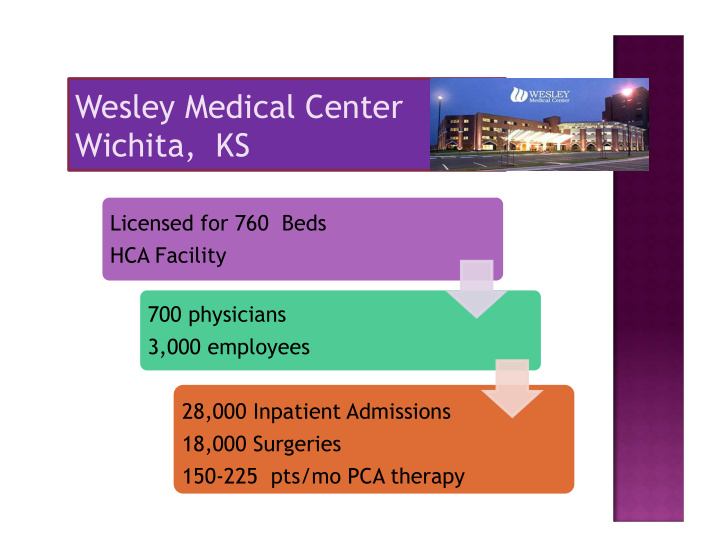



Wesley Medical Center Wichita, KS Licensed for 760 Beds HCA Facility 700 physicians 3,000 employees 28,000 Inpatient Admissions 18,000 Surgeries 150-225 pts/mo PCA therapy
Wesley’s Experience: Previous Strategies Implemented 2002-2007 Strategies Strategies Preprinted PCA by PCA Order Increased Proxy sets; emphasis on education pain management Eliminated basal rates; eMAR Established Increase in documenta- dosing tion for Opioid ranges; related bolus and Eliminated shift totals ADRs Meperidine
Wesley’s Results Opioid ¡ADRs ¡by ¡ 2007 2008 Severity %Mild 47.80% 36.4% %Mod 32.60% 49% %Severe 19.60% 14.60% %Code ¡Mod/Severe ¡ 37.50% 31.40% (All ¡Opioids) % ¡Code ¡Mod/Severe ¡ (PCA ¡Only) 16.70% 11.4%
Wesley’s Experience: Implementation of Smart Pump Technology • Expanded Multidisciplinary Implementation Team • Identification of High Risk Patients 2009 • All patients screened on admission • Modified STOP BANG score • Conversion to “Smart” Pump system • Included Capnography May • Policy/Procedures to monitor all PCA pts and all High Risk patients receiving IV opioids for first 48 hours 2009 • Effective pain management • Reduce Severe Adverse Drug Events Goal • Improve Patient Safety
Wesley’s Experience: PCA volumes and Risk Scoring 2010 2011 2012 PCA Stats Total PCA Orders 4122 3531 2268 Total PCA Patients 3580 3114 2037 Orders Using Order Set 4037 3472 2267 % PCA Ord Using OS 97.94% 98.33% 99.96% Patient Risk Scoring Total PCA Pat w/ RS 3118 2961 1923 High Risk 178 156 170 Low Risk 2645 2428 1551 Missing 488 265 114 Diagnosed 274 251 202 Not Eval 0 14 0 % Pats w/PCA Ord w/RS 87.09% 95.09% 94.40%
Wesley’s Experience: Results Opioid ¡ADRs ¡by ¡ 2010 2010 ¡ Severity 2007 2008 2009 ¡pre-‑ETCO2 post-‑ETCO2 2011 2012 %Mild 47.80% 36.4% 35.1% 27.6% 54.2% 45.9% 60.2% %Mod 32.60% 49% 51.4% 41.4% 39.0% 50.5% 35.6% %Severe 19.60% 14.60% 13.50% 31.0% 6.80% 3.6% 1.4% %Code ¡Mod/Severe ¡(All ¡ Opioids) 37.50% 31.40% 20.80% 42.8% 11.1% 10.0% 10.3% % ¡Code ¡Mod/Severe ¡ (PCA ¡Only) 16.70% 11.4% 12.5% 14.3% 3.70% 1.7% 3.4%
Wesley’s Experience: Transfer to ICU % PCA ADRs Transfer to ICU 80% 70% 60% 50% 40% 30% 20% 10% 0% pre-2010 post 2010 2011 2012
Wesley’s Experience: ADRs by Severity Opioid Adverse Drug Reactions By Severity 0.7 0.6 0.5 0.4 %Mild %Mod 0.3 %Severe 0.2 0.1 0 2007 2008 2009 2010 pre 2010 post 2011 2012
Wesley’s Experience: Code Prevalence Code Prevalence in Moderate and Severe Opioid Adverse Drug Reactions 0.45 0.4 0.35 0.3 0.25 0.2 0.15 0.1 0.05 0 2007 2008 2009 2010 pre 2010 post 2011 2012 %Code Mod/Severe (All Opioids) % Code Mod/Severe (PCA Only)
Wesley’s Experience: On-going Performance Improvement Reduce Severity in Non-PCA ADRs Dec. ’12: Methodology Monitor all to identify Medical Post-op pts other risk patients receiving IV factors for receiving IV opioids for 1 st respiratory opioids? 24 hrs depression?
Wesley’s Experience: Lessons Learned Staff Education: Patient ETCO2 Education Pulse Oximetry Management Team of Alarms Collaboration ETCO2 an effective tool for early detection of Respiratory Depression
In recognition for our efforts to improve patient-controlled analgesia (PCA) outcomes, Wesley Medical Center was honored by the Institute of Safe Medication Practice with the Cheers Award in 2012.
Recommend
More recommend